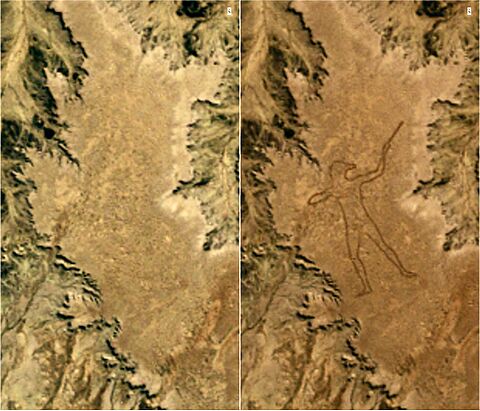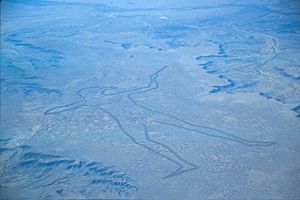Marree Man facts for kids
The Marree Man, also known as Stuart's Giant, is a huge drawing on the ground called a geoglyph. It was found in 1998. It looks like an Indigenous Australian man hunting with a boomerang or a stick.
This giant artwork is located on a flat area about 60 km west of the town of Marree in central South Australia. It's about 2.7 km tall, which is like walking almost three times around a standard running track! The lines that make up the figure stretch for 28 km.
The Marree Man is one of the biggest geoglyphs in the world. But here's the mystery: no one knows who created it! No one has ever claimed responsibility, and no one saw it being made, even though it would have been a huge job. It was accidentally spotted by a pilot flying over the area on June 26, 1998.
Soon after it was found, the South Australian government temporarily closed the site. This happened because of legal action from groups claiming traditional ownership of the land. However, flights over the area were still allowed.
Contents
What the Marree Man Looks Like and How it Changed
The Marree Man geoglyph shows a man holding either a woomera (a throwing stick) or a boomerang.
Some people noticed that the outline of the Marree Man looks very similar, but reversed, to an ancient Greek statue called the Artemision Bronze. This statue was found in the sea in 1928.
When the Marree Man was first discovered, its lines were about 20 to 30 cm deep. They were also up to 35 meters wide.
Over time, natural weather slowly wore away the lines. However, because the area is very dry, the image was still visible even in 2013.
Scientists compared satellite images from NASA's Landsat-5 satellite. They found that the Marree Man was created between May 27 and June 12, 1998. The images show the desert area going from empty to having the completed figure.
Satellite Images Showing Creation
In August 2016, people worked to make the geoglyph clear again. They used a machine called a grader and GPS technology. This work made the outline easy to see from the air once more. Some people think that the original artwork could not have been made without GPS, which was quite new back then.
How the Marree Man Was Found
A pilot named Trec Smith was flying between Marree and Coober Pedy on June 26, 1998. He was the first to see the giant figure from the sky. Australians were very interested in this discovery because of its huge size and the mystery of who made it.
Shane Anderson, who worked at the William Creek Hotel, said they received an anonymous fax. This fax described where the artwork was located.
Mysterious Messages
Several anonymous messages were sent to news outlets and local businesses in 1998. These messages suggested that the Marree Man might have been created by people from the United States. The messages used words like "your State of SA" and mentioned the "Queensland Barrier Reef". They also talked about Indigenous people using terms not common in Australia. Some thought these clues might have been put there on purpose to make people think Americans made it.
Clues Left Behind
On July 16, 1998, a small glass jar was found at the site. It was in a newly dug trench. Inside the jar was a satellite photo of the Marree Man. There was also a note with a U.S. flag and references to "Stuart's Giant."
In January 1999, another fax was sent. It described a special plaque buried 5 meters south of the figure's nose. This plaque had an American flag on it and the Olympic rings. It also had these words:
In honour of the land they once knew. His attainments in these pursuits are extraordinary; a constant source of wonderment and admiration.
These words came from a 1946 book called The Red Centre by Hedley H. Finlayson. The book described how the Pitjantjatjara tribe hunted wallabies with throwing sticks.
Who Might Have Created It?
One person suggested as the creator is Bardius Goldberg. He was an artist from the Northern Territory who passed away in 2002. He was known for wanting to create art that could be seen from space. When asked, Goldberg never said if he made the Marree Man or not.
Others have wondered if members of the Australian Army or American soldiers stationed at Woomera might have been responsible.
How People Reacted
Most people and the news were excited about the Marree Man. The Advertiser, a local newspaper, even suggested making the figure permanent. They thought the outline could be dug deeper to reach a layer of white chalk.
At the time of discovery, there was a legal case about who owned the land. Two Indigenous groups, the Arabunna people and the Dieri Mitha, were in a dispute. The Dieri Mitha group said the artwork harmed their traditional beliefs, called Dreamtime. They asked for the image to be removed and for the artist to be punished. Because they were claiming ownership of the land, the Dieri Mitha took legal action to stop flights and visitors. This led the state government to close the area to the public. The Arabunna group also said the area had important historical sites. In 2012, a court decided that the Arabunna people were the traditional owners of the land.
Some officials were not happy about the artwork. The former Environment Minister, Dorothy Kotz, called it "environmental vandalism". The head of Aboriginal affairs in South Australia, David Ruthman, called it "graffiti".
In June 2018, adventurer Dick Smith said he had a team investigating the Marree Man's origins for two years, but they found nothing. He offered a A$5,000 reward for information about its creators. The South Australian state government later said they would not take legal action against the creators if they were identified.
See also
- Cerne Abbas Giant
- Long Man of Wilmington
- Petroglyph



